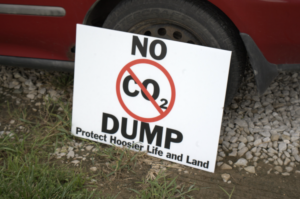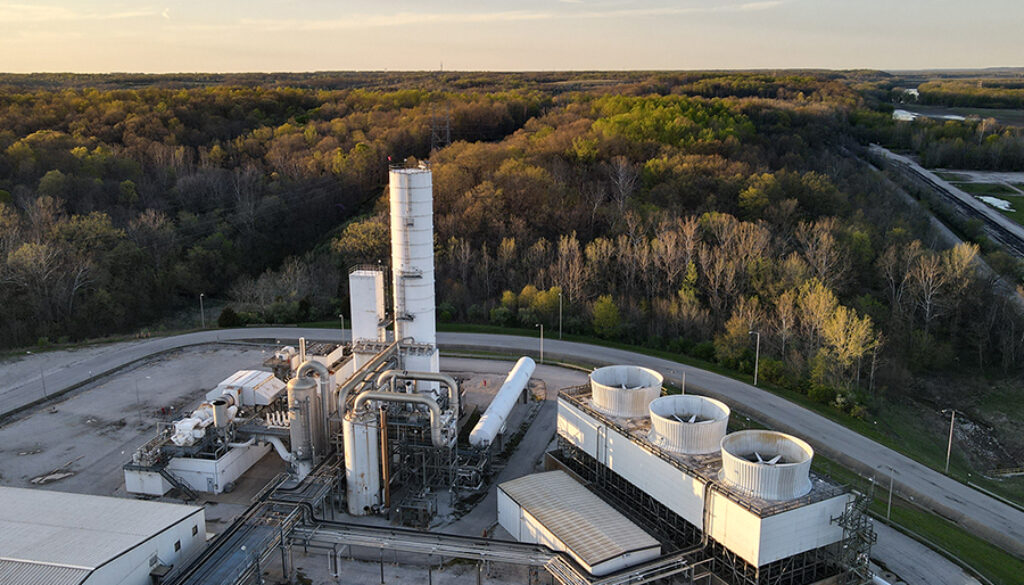As hydrogen projects accelerate, fears mount about environmental impacts
On a recent hot August evening, residents of the tiny rural community of Universal, Indiana packed into a public meeting to barrage operators of a proposed fertilizer plant with questions about what risks the project may pose for their health and the surrounding environment.
One after the other, worried residents quizzed officials with Wabash Valley Resources about their plans to construct what would not just be a fertilizer plant, but also one of the nation’s largest carbon sequestration projects, near their town of less than 400 people.
Wabash proposes to produce hydrogen and anhydrous ammonia for fertilizer through a process that will capture and store the resulting carbon dioxide created by the plant underground. When the plant is fully operational, Wabash Valley Resources expects to inject and store 1.65 million tons of carbon dioxide into the ground.
Company officials say the operation will be safe, producing affordable and much-needed fertilizer for farmers in an environmentally friendly manner. “While empowering agriculture Wabash Valley Resources will play a vital role in the transition to a greener world, ensuring energy security and supporting a robust economy,” the company states on its website.
Residents are skeptical. In the August 16 meeting, several voiced concerns — in raised voices and with pointed fingers — about risks to their water quality, potential leaks of carbon dioxide, and fear the project could cause earthquake-like tremors and property damage.
“It is insane,” said Kerwin Olson, the executive director of Citizens Action Coalition, an Indiana-based environmental advocacy organization. “It is the epitome of brutal capitalism done on the backs of taxpayers and our environment.”
Hydrogen boom
The Wabash Valley Resources proposed facility is one of scores of similar projects planned or getting underway around the country after last year’s passage of the Inflation Reduction Act created new incentives for hydrogen-related projects. Under the IRA, hydrogen operations can receive generous tax credits, depending on the carbon intensity of the production process.
Though hydrogen is currently most commonly used in the US as an ingredient in fertilizer and drug production, it has also emerged as a promised clean alternative to fossil fuels. The US Department of Energy (DOE) is expected to announce allocations of $7 billion of funding this fall for up to 10 new “hydrogen hub” projects across the country to support hydrogen producers and transportation infrastructure meant to accelerate the industry.
Hydrogen fuel can be made in a number of different ways, often referred to by associated colors. Green hydrogen, for example, refers to hydrogen produced from water, exclusively by using other renewable energy sources such as wind or solar energy to power the process. Gray and blue hydrogen refers to hydrogen produced from methane, using any form of energy to power the process.
Producing green hydrogen has no direct greenhouse gas emissions. But gray and blue hydrogen production creates carbon dioxide (a planet-warming greenhouse gas) as a by-product, which is then either released into the atmosphere (in the case of gray hydrogen) or captured and stored (in the case of blue hydrogen).
Black hydrogen is the least environmentally friendly form and refers to a process that uses coal to power hydrogen production. Currently, 99% of the United States’ supply of hydrogen is sourced from fossil fuels such coal, according to the DOE.
Environmental advocates nationwide have pushed back against gray and blue hydrogen projects, since sourcing the necessary methane to produce the hydrogen could provide revenue for fossil fuel companies, and since the production process creates carbon dioxide, which contributes to harmful climate warming.
Instead, environmental advocates tend to support green hydrogen, which is produced only with renewable energy.
“New hydrogen projects must be evaluated to ensure that they are not simply an attempt to prop up the fossil fuel industry,” wrote Sierra Club staff in a report.
Wabash Valley Resources says it plans to create hydrogen using petcoke, a by-product of oil refining, and environmental waste, also known as biomass.
Awaiting guidance
The Biden Administration is expected to release detailed guidelines for its hydrogen program before the end of the year.
The guidelines could require hydrogen companies to prove that they’re consuming 100% renewable energy to produce their hydrogen fuel, a move that would help prevent emissions-intensive hydrogen projects, but could restrict the deployment of new hydrogen projects.
Hydrogen proponents are pushing for more relaxed guidelines. A group of industry consultants determined in a report earlier this year that stricter guidelines would be “ultimately hindering the economic competitiveness and adoption” of green hydrogen.
“When it comes to meeting climate targets, green hydrogen will need to be deployed alongside other solutions, therefore the sooner adoption occurs, the sooner benefits can be realized,” the authors wrote.
In contrast, a coalition of scientists and environmental organizations sent a letter to the Biden Administration earlier this year asking for rigorous guidelines for the sector. Failing to do so, the coalition wrote, could cause the federal government to spend more than $100 billion subsidizing hydrogen projects that would result in a net increase in emissions.
“Looser requirements … will result in a grim U-TURN for the power sector, in the form of emissions increases,” Rachel Fakhry, a policy director at the National Resources Defense Council, wrote in a related report. “This would be completely unacceptable.”
“Guinea pigs”
Back in Indiana, residents say there is a lack of adequate research on the potential environmental and safety hazards associated with injecting the carbon dioxide generated by hydrogen production into underground storage. In their view, Wabash Valley is running what amounts to a risky experiment with their land and their lives.

“They are asking for folks … to be the guinea pigs,” Olson said.
Pete Rimsans, a representative for Wabash Valley Resources, said in a statement to The New Lede that carbon capture and sequestration has a safe track record worldwide, and that the Environmental Protection Agency’s (EPA’s) issuance of permits to the project named the injection sites as “suitable for permanent carbon sequestration.”
“The EPA has spent two years reviewing the draft permits, with public health and safety being its number one priority … We are committed to working with our local communities as stewards of the environment as we work to address the national priorities of reducing greenhouse gas emissions and the dependency on imported fertilizers,” he said.
Across the Ohio River Valley, in Mason County, West Virginia, another similar plan is underway to tap taxpayer money to build a riverside hydrogen production facility. Fidelis Clean Energy LLC, plans to produce over 100,000 tons of hydrogen per year with the help of a recently approved $62.5 million loan from the state.
Fidelis also has plans to inject 10 million tons of carbon dioxide emissions in underground storage annually. Fidelis’ West Virginia project proposes to produce gray hydrogen, and to store the carbon dioxide byproduct by capturing and injecting it underground. Fidelis did not respond to requests for comment.
(Featured image: The existing waste-to-energy facility at the site where Wabash Valley Resources plans to produce hydrogen to make fertilizer. Credit: Wabash Valley Resources.)
 EWG
EWG


